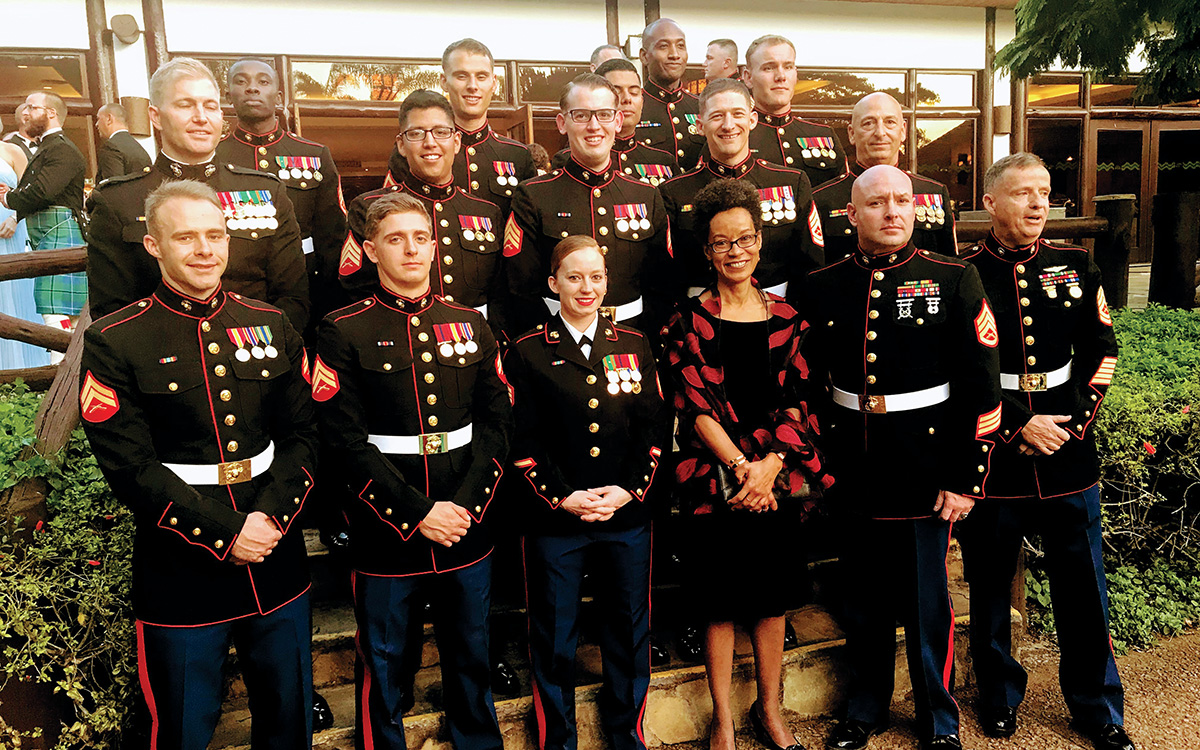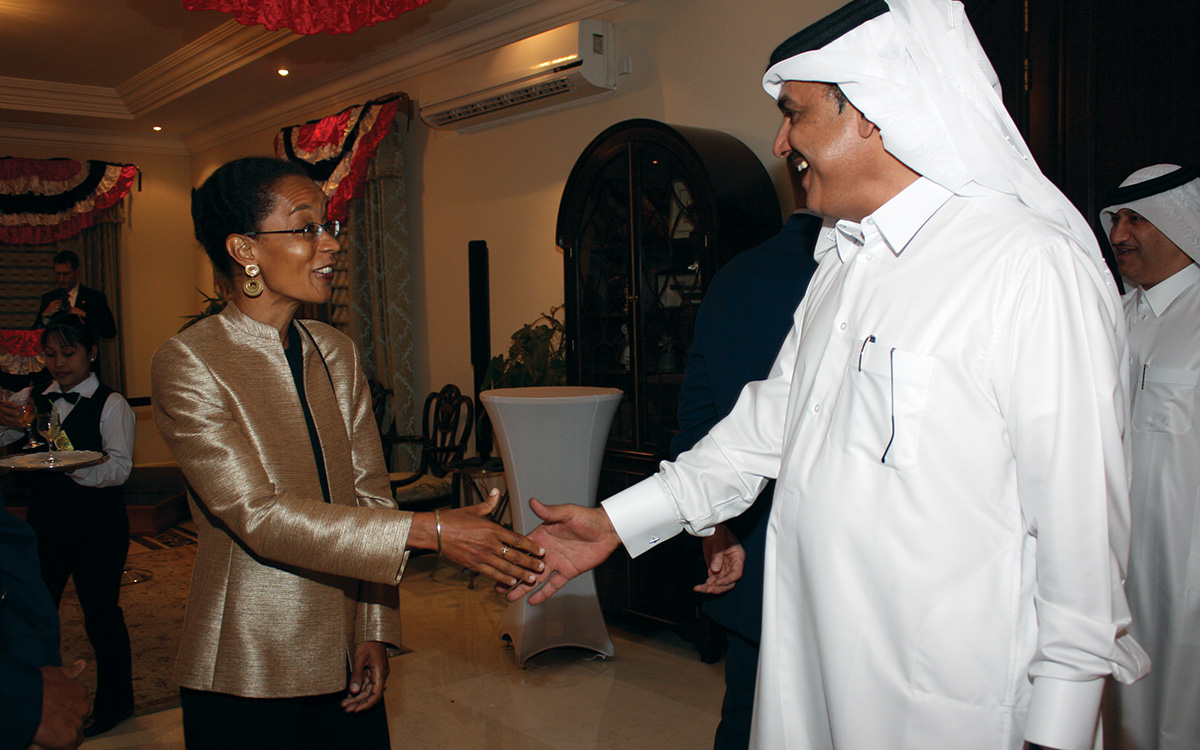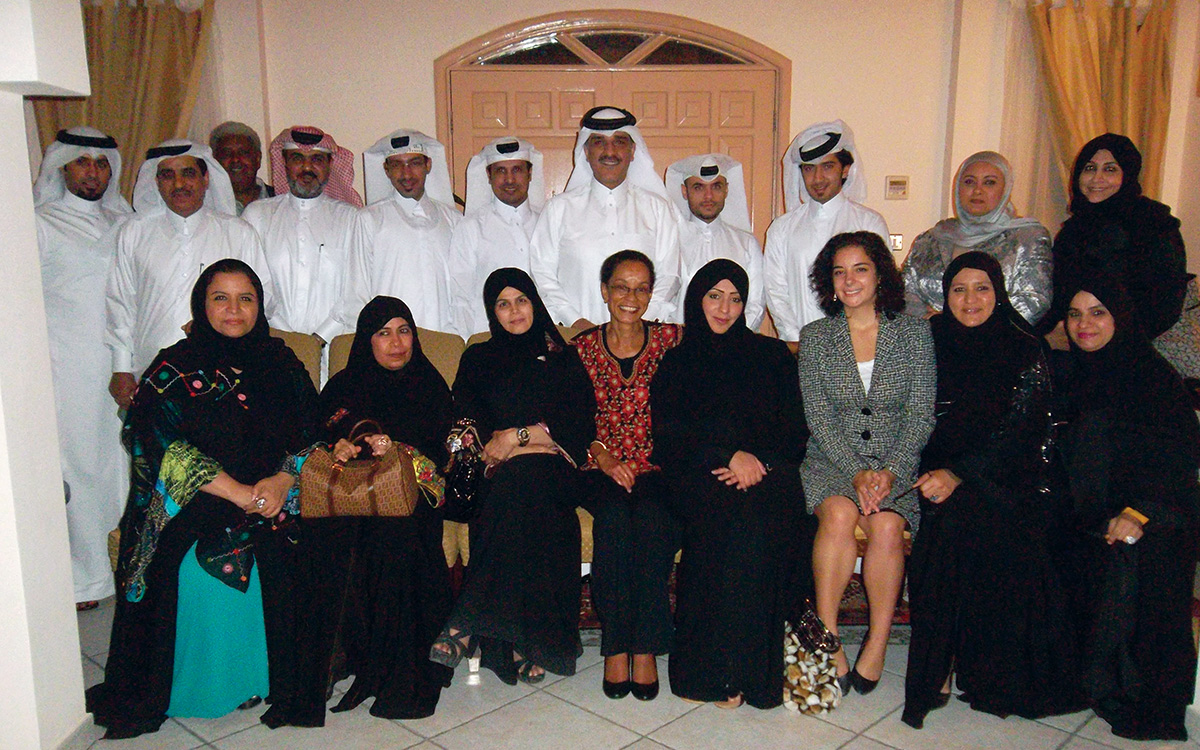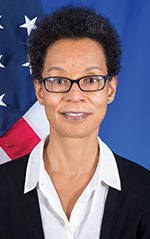Inclusion Helps Drive Diversity
State’s new initiatives create space for difficult conversations and incorporate accountability.
BY MIREMBE NANTONGO

DCM Mirembe Nantongo, center, with the U.S. Embassy Nairobi Marine Security Guard detachment at the Marine Ball in November 2017.
Courtesy of Mirembe Nantongo
It is said that diversity is being invited to a party, inclusion is being asked to dance. Without inclusion, in other words, the full power of an institution’s diversity remains untapped.
Diversity has long been recognized as not just a laudable goal, but an institutional imperative. Diversity is about people and often involves discussions of data, while inclusion is about culture and concerns the way we behave. Data are important to our diversity efforts, and the State Department maintains a robust diversity data collection framework that serves as a progress indicator and enables barrier analysis. We are also increasing data transparency and encouraging workforce discussions around the data.
At the same time, we are encouraging a newer and much broader conversation, across the institution, that goes beyond the data: a conversation on inclusion. The numbers are important, yes, but there is a story—and an entire culture—behind the numbers, and it is time to focus on that. In the wake of the brutal killing of George Floyd, the department has seen exponential growth in interest in creating space for difficult conversations on inclusion and on how our Black and other minority colleagues have faced challenges in both personal and professional fora. In response, State Department leadership has reaffirmed its commitment to shifting our culture to speak up against discrimination and ensure it has no place in our ranks. The diversity and inclusion unit alongside partners in the State Department’s Office of Civil Rights are helping to facilitate robust dialogue to change our institutional culture and to identify concrete steps for those interested in being allies on these issues.
Under Secretary for Management Brian Bulatao put it clearly when he launched a task force for the Diversity and Inclusion Strategic Plan (DISP) in January 2020: Diversity and inclusion must go together—you cannot have one without the other.
It is said that diversity is being invited to a party, inclusion is being asked to dance.
Workplace inclusion at the State Department concerns our culture, how we behave. This can mean everything from whether we use standardized questions for interviews and the channels we establish for open conversations between leadership and staff, to the way we treat each other on a daily basis. An inclusive organizational culture sustains the supportive and respectful environment in which everyone can reach their full potential. Inclusion helps drive diversity by attracting the most qualified applicants from a wide variety of backgrounds and then retaining them and maximizing their performance.
Time and time again, research has shown that diverse and inclusive teams are more innovative and cohesive, make better decisions, and provide a competitive edge in recruitment and retention. At the State Department, this means that a diverse workforce and inclusive culture equip us to better advance U.S. foreign policy interests and deliver results for the American people. Embracing and empowering talent from across all walks of life brings creativity to the workplace and strengthens our ability to confront the array of increasingly complex international challenges we are entrusted to solve. Diversity and inclusion, together, are essential to achieving unity in our workforce in furtherance of our mission and supporting our State Department ethos.
The 2020-2022 Diversity and Inclusion Strategic Plan
Shifting the organizational culture of America’s oldest, most geographically dispersed Cabinet agency is no easy task. It requires a clear road map and buy-in from all corners of the institution. Recognizing that diversity and inclusion are indispensable to successfully carrying out our mission at home and overseas, senior leaders throughout State have committed to shaping its future through the 2020 DISP, which will be published later this year. Grounded in clear, actionable milestones and performance indicators, the plan aims to focus the department’s efforts, ensure accountability, and measure outcomes to inform future initiatives.
The State Department’s commitment to diversity and inclusion is not new; the 2020 DISP is the third of its kind. However, an important lesson from the previous DISP was that we must act collectively to achieve our diversity and inclusion goals. As a result, the 2020 DISP, for the first time, incorporates feedback from a department-wide task force of more than 40 bureau representatives and all employee groups, and it offers a cohesive and practical vision to guide our efforts with built-in accountability measures.
The numbers are important, yes, but there is a story—and an entire culture—behind the numbers, and it is time to focus on that.
Drawing on the wealth of ideas and innovative solutions proposed by the DISP task force and our many employee groups, the department aims to achieve a fully integrated, “gold-level” diversity and inclusion framework, as measured by the Office of Personnel Management’s “Diversity and Inclusion Framework Matrix” for federal agencies. In aiming for gold, and while retaining focus on the traditional OPM-defined minority categories, we are requiring leaders to consciously maximize organizational performance through inclusive practices; we are dedicating resources to advance diversity and inclusion; and we are acting collectively. These goals frame the three key objectives of the 2020 DISP, which incorporates critical themes, milestones and action in the three areas that fundamentally drive diversity and inclusion: recruitment, retention and employee advancement.
The Bureau of Global Talent Management and the Office of Civil Rights will review the plan annually to assess progress, and a full update is scheduled for 2022. We are putting in place a two-year plan rather than the typical four-year plan to better mesh with the department’s 2018-2022 Joint Strategic Plan’s timeline. This will ensure that our diversity and inclusion goals are formally embedded in the department’s JSP process so that bureaus and missions have alignment and consistency in how operating units execute lines of effort. The DISP will then be updated in alignment and integration with the upcoming 2022-2026 JSP process.
Within the DISP, we have outlined milestones and performance indicators that we will reassess at the end of the year. Our goal is to hold each other accountable for the implementation of the DISP, which is why we will rely on our partnerships with bureau diversity councils, employee affinity groups and senior leadership.
A Workforce That “Looks Like America”
The State Department is the face of America overseas, and it has a unique mandate to fully represent the country and people we serve. An important piece of that puzzle is ensuring that the department recruits, retains and develops a diverse and high-performing workforce. It begins with providing fairness, transparency and opportunity to all applicants and employees throughout the talent life cycle and then ensuring the diversity that strengthens us is reflected in our senior ranks.
The department emphasizes the search for diverse talent through its national talent acquisition platform, which places recruiters around the country to seek competitive candidates from all backgrounds. Recruiters identify candidates on university campuses, in professional association gatherings and by engaging with communities underrepresented at the department. They cultivate internship, fellowship and career candidates at Historically Black Colleges and Universities, Hispanic-serving institutions, and tribal colleges and universities, among other places.
They recruit skilled professionals through alumni networks, trade organizations and targeted career fairs. They also meet candidates where they are, online. The State Department has long had an online presence and has stepped up its virtual recruitment activities dramatically since March with the cancellation of most in-person events.
Thousands of Americans pursue a career in diplomacy each year, and the State Department has several programs designed specifically to make a foreign affairs career accessible to competitive individuals from historically underrepresented groups. The Pickering and Rangel Fellowships, the U.S. Foreign Service Internship Program and the Foreign Affairs Information Technology Fellowship are all important programs that directly and successfully support the recruitment of diverse talent.

Deputy Chief of Mission Mirembe Nantongo greets guests at the July 4 reception in Doha, Qatar, in 2010.
U.S. Embassy Doha / Pappu Dakin
Focus on Retention
To stand the test of time and translate into a Senior Foreign Service that looks more like America, however, effective strategic recruitment must be accompanied by internal cultural shifts. An inclusive work environment that ensures employees feel respected, valued, heard and empowered is crucial to retaining and developing talent to rise through the ranks. Recognizing that the department has work to do in this regard, Director General of the Foreign Service and Director of Global Talent Carol Perez is committed to making this happen.
Underscoring the importance of fostering a culture of inclusion at the department, DG Perez has introduced new workplace flexibilities within her authority, advocated for new ones to Congress and enhanced existing programs to maximize the performance, career development and professional satisfaction of employees. These initiatives include an extended Leave Without Pay pilot program, additional lactation rooms and flexible lunch schedules. Recently, as a result of the COVID-19 pandemic, most of the workforce has become familiar with telework. It will be interesting to see how many telework-eligible employees continue to make use of this option once the pandemic abates.
Understanding and mitigating unconscious bias are other essential elements in strengthening diversity and inclusion at all levels of the State Department. Science tells us that unconscious bias is a natural and necessary response to processing the millions of bits of information we are all exposed to at any given moment. But this unconscious process can introduce inequities into activities such as recruitment, interviewing, performance recognition or task assignment. Often, we are unaware that bias is affecting our decision-making at all. Yet unconscious bias can have a major impact on an employee’s career—from hiring to career progression and promotion—as well as on how teams and, therefore, our workforce are constituted.
Grounded in clear, actionable milestones and performance indicators, the 2020 DISP aims to focus the department’s efforts, ensure accountability, and measure outcomes to inform future initiatives.
State takes unconscious bias seriously and has taken several major steps to raise employees’ awareness of bias and mitigate its effects on department-wide procedures. Institutional actions to tackle unconscious bias, whether in recruitment, hiring, performance evaluation or task allocation, are incorporated throughout the 2020 DISP. But understanding and mitigating one’s own biases is also a personal responsibility. Fortunately, employees do not have to do it alone—in 2019, the Foreign Service Institute launched a new course on “Mitigating Unconscious Bias” (PT-144), available both in classroom and online versions to our global workforce. FSI reports that as of early August, 11,500 employees have taken the course in person or online since October 2019.
The Bureau of Global Talent Management and Office of Civil Rights’ joint initiative called Open Conversations is another burgeoning effort. Allowing safe, candid, constructive and voluntary conversations on issues that affect inclusion, these facilitated sessions can be hosted by bureaus, offices or employee groups. Most recently, dozens of Open Conversations across the department have covered the sensitive topic of race and the professional and personal experiences of Black employees and persons of color. Topics covered previously in Open Conversations include “Employment Labels at State,” “I Want to Speak to a Real American” and “Managing Generational Differences.”
Everyone Has a Role to Play
Diversity and inclusion enhance the performance and effectiveness of organizations. The State Department can reap the proven benefits of diversity and inclusion by maximizing employee and team performance through inclusive practices. Imagine this—tackling global challenges and advancing U.S. interests with stronger institutional cohesiveness, more nuanced decision-making and innovative approaches to diplomacy. Embracing diversity and practicing inclusion is a collective responsibility for each and every member of the State Department family—from the newest intern and line manager to chiefs of mission overseas and the department’s senior leadership. This not only enhances our performance, but it also reflects the best of our diverse workforce.
Change is made possible only by the actions we each choose to take at work every day. Inclusion is the key to unlocking the power of diversity. Let’s turn the key together, one decision and one action at a time.
Personal Reflections on This Moment at State

Deputy Chief of Mission Nantongo, at center, and Cultural Affairs Officer Erica Chiusano, third from right, with a group of International Visitor Leadership Program alumni in Doha in 2011.
U.S. Embassay Doha / Sunny Tholath

DCM Nantongo with her sons, Dominic (at left) and Sebastian, when they visited her in Kenya in June 2018.
Courtesy of Mirembe Nantongo
As I retire after a 25-year career, I realize that close to half my life has been spent as a State Department employee. Starting as a Locally Employed staff member in the General Services Office at U.S. Embassy Kampala, I spent the next six years as an Eligible Family Member before joining the State Department as a Foreign Service officer in 1995. I have served and lived in Latin America, the Middle East, Africa and Washington, D.C. Although coned as a political officer, I have worked in all five Foreign Service cones, served twice as a deputy chief of mission and, finally, as a deputy assistant secretary.
Both my sons (now 19 and 28) were born under the Foreign Service umbrella and spent their childhoods in international schools overseas. Influenced by top-notch Embassy Marine Security Guards at our various assignments, both are now U.S. Marines themselves—one on active duty and the other recently graduated from college. It is a source of great pride to me that all three of us have taken the oath of office, with its solemn commitment to the Constitution and to public service. It has been a truly fabulous career, and I have enjoyed or learned from every moment.
A child of African and European parents, I was born in Africa and grew up biculturally between Africa and Europe, at home and yet not fully belonging in either place. I came to the United States as an immigrant in 1987 and was naturalized in 1991 before formally joining the Foreign Service in 1995. After rather awkwardly straddling my parents’ two very homogenous cultures all my life, I reveled in the vibrant heterogeneity of the United States, where any fellow citizen might have any cultural heritage and any appearance, name or accent.
My youth in Africa was framed by an unapologetically patriarchal society, over which the ghost of colonialism still hovers; but I learned early on that the Black American experience, and the legacy of slavery, represented a dreadfully distinct and painful universe about which I understood little. Thirty years as an American citizen, much self-education and living and working alongside Black friends and colleagues has made me better informed, both intellectually and emotionally, but I know there is still much to learn and understand.
The brutal killing of George Floyd has horrified us all, and the accompanying national upheaval and introspection have been vividly reflected within the State Department. In an institution known for its staid, traditional professionalism, open conversations around issues affecting diversity and inclusion are still a new phenomenon, but they are blossoming rapidly. Leaders and colleagues are participating in difficult discussions across the institution on race and racism, privilege, unconscious bias, microaggressions and allyship.
These exchanges are opening the eyes of many of our colleagues to the indignities, disrespect and marginalization suffered routinely by Black colleagues and persons of color both inside and outside the workplace. Colleagues are understanding that while rules and policies are important, individual action and commitment are just as important for shifting our culture. The days of standing by are over. From hour to hour, from minute to minute, is every one of us walking the walk, opening our hearts, and recognizing and interrupting bias where we encounter it? Do we understand privilege, and are we everyday active partners in making our national values of justice and equality a lived experience for all?
Change is hard, and shifting a culture happens one person at a time, one action at a time, until a tipping point is reached. As I retire, I am heartened and inspired by my colleagues’ determined energy around the issue and our collective hunger for change. I know we will get there.
—Mirembe L. Nantongo
Read More...
- “Diversity and Inclusion Efforts that Really Work,” David Pedulla, Harvard Business Review, May 12, 2020
- “House Lawmakers Examine Lack of Diversity at State Department,” by Pranshu Verma, NYT, June 17, 2020
- “Toward a Foreign Service Representing America,” by Lia Miller, FSJ, June 2015




